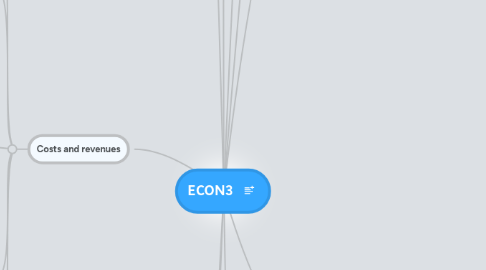
1. Costs and revenues
1.1. Fixed and variable costs
1.1.1. Fixed costs
1.1.2. Variable costs
1.2. The SRAC curve
1.2.1. Short run
1.2.2. The law of diminishing returns
1.2.2.1. Average product
1.2.2.1.1. Average variable product
1.2.2.2. Division of labour
1.3. The LRAC curve
1.3.1. Economies of scale
1.3.1.1. Technicla
1.3.1.2. Purchasing
1.3.1.3. Financial
1.3.1.4. Administrative
1.3.2. Diseconomies of scale
1.3.2.1. Factors
1.3.2.1.1. Control
1.3.2.1.2. Co-ordination
1.3.2.1.3. Co-operation
1.3.3. Economies of scope
1.4. The Minimum Efficient Scale
1.4.1. Exhausted economies of scale
1.5. External Economies and Diseconomies
1.5.1. Clusters
1.5.1.1. Cheap raw materials
1.5.1.2. Labour market (special skills)
1.5.1.3. Shared factors of production
1.5.1.4. Exchange of ideas
1.6. Total, average and marginal revenue
2. Efficiency
2.1. Consumer and produser surplus
2.1.1. Consumer surplus
2.1.2. Producer surplus
2.2. Static efficiency
2.2.1. X efficiency
2.2.1.1. Not on AC curve- monompoly
2.2.2. Economic efficiency
2.2.2.1. Allocative efficiency
2.2.2.1.1. P=MC
2.2.2.2. Productive efficiency
2.2.2.2.1. MES
2.3. Dynamic efficiency
2.3.1. R and D
2.3.1.1. Product inovation
2.3.1.2. Process inovation
2.3.2. Technological change
2.3.3. Increased physical capital
2.3.4. Increased human capital through education and training
3. Concentrated Markets
3.1. Why do firms grow large?
3.1.1. Market power
3.1.1.1. Price discrimination
3.1.1.2. Increasing pricing power
3.1.2. Objectives of managers
3.1.3. Profit motive
3.1.3.1. Escape the take-over
3.1.3.1.1. Maintain high share value
3.1.4. Risk motive
3.1.4.1. Diversification of production
3.1.4.1.1. Economies of scope
3.2. How do firms grow larger?
3.2.1. Internal growth
3.2.2. External growth
3.2.2.1. Horizontal (same industry, same stage) integration
3.2.2.2. Vertical integration (different stages of the supply chain)
3.2.2.3. Lateral merger (related but not identical)
3.2.2.4. Conglomerate merger (unrelated)
3.3. Outsourcing
3.3.1. Technological change
3.3.2. Increased competition
3.3.3. Pressure from the financial markets
4. Oligopoly
4.1. Definition
4.1.1. Few producers
4.1.2. Consenration ratio of top 5 is more than 60%
4.1.3. Interdependence
4.2. Conduct and behaviour
4.2.1. Product branding
4.2.2. Non-price competition
4.2.3. Entry barriers
4.2.4. Interdependence and uncertainty
4.3. Kinked demand
4.3.1. Elastic above equilibrium
4.3.2. inelastic beneath equilibrium
4.4. Importance of non-price competition
4.4.1. Better quality of service
4.4.2. Longer opening hours
4.4.3. Discounts on product upgrades
4.4.4. An increased range of services
4.4.5. Advertising and loyalty cards
4.5. Price leadership and tacit collusion
4.5.1. Price fixing
4.5.2. Cartel agreements
4.5.2.1. Enforcement problems
4.5.2.1.1. Cheating
4.5.2.2. Falling market demand
4.5.2.3. Entry of non-cartel firms into the industry
4.5.2.4. The wxposure of illegal price fixing by market regulators
4.5.3. Benefits from collusion
4.5.3.1. Joint R and D projects
4.5.3.2. Joint use of facilities
4.5.3.3. Adoption of common standards
5. Contestable markets
5.1. No barriers
5.1.1. To entry
5.1.2. To exit
5.1.3. + access to the same technology
5.2. Costs of entry/ exit are 0
5.3. Downward pressure on prices
5.4. The increasing contestability of markets
5.4.1. Risks
5.4.1.1. New technology
5.4.1.2. New strategy
5.4.2. De-regulation of markets
5.4.3. Competition policy
5.4.3.1. Against price fixing cartels
5.4.3.2. Against predatory behaviour
5.4.4. The European Single Market
5.4.5. Technological change
5.4.5.1. e- commerce
6. Perfect Competition
6.1. Free market
6.1.1. Many buyers and sellers
6.1.2. No barriers to entry
6.1.3. Identical products
6.1.4. Perfect information
6.1.5. No externalities
6.1.6. No economies of scale
6.1.7. Prcetakers
6.2. Benefits of competition
6.2.1. Lower prices
6.2.2. Low barriers to entry
6.2.3. Lower total profits
6.2.4. Economic efficiency
6.2.5. Greater entrepreneurial activity
7. Profit Maximisation
7.1. Profit
7.1.1. Normal
7.1.2. Supernormal
7.2. Maximizing profit
7.2.1. MC=MR
7.3. The role of profit
7.3.1. Functions of profit
7.3.1.1. Allocation of factors of production
7.3.1.2. Signal for market entry
7.3.1.2.1. High supernormal profit
7.3.1.3. Promotes innovation
7.3.1.3.1. Dynamic efficiency
7.3.1.4. Investment
7.3.1.5. Reward for bearing risk
7.3.1.6. Performance indicator
7.4. Alternative goals
7.4.1. Traditional
7.4.1.1. Profit maximisers
7.4.1.2. Owners are managers
7.4.2. Managerial theory
7.4.2.1. Maximisation of sales
7.4.2.2. Or market share
7.4.2.3. Principle agent problem
7.4.2.4. Divorce between ownership and control
7.4.3. Behavioral theories
7.4.3.1. Complex
8. Price Discrimination
8.1. Identical Product
8.1.1. Different buyers
8.1.1.1. Different prices
8.2. Conditions
8.2.1. Differences in PED
8.2.2. Barriers to prevent "market seepage"
8.2.2.1. MAC for students
8.3. Types
8.3.1. Ist degree
8.3.1.1. Unique price
8.3.1.1.1. Doctors
8.3.2. IInd degree
8.3.2.1. Quantity
8.3.2.1.1. Multi pack
8.3.3. IIIrd degree
8.3.3.1. Time
8.3.3.1.1. Train ticket
8.3.3.2. Geography
8.3.3.2.1. Drugs for Africa
8.3.3.3. Status of consumer
8.3.3.3.1. Students
9. Monopoly(25%+)
9.1. Barriers to entry
9.1.1. High fixed costs
9.1.2. Economies of scale
9.1.3. Brand loyalty
9.1.4. Legal barriers
9.1.5. Control over the factors of production
9.1.6. Control over retail outlets
9.1.7. Predatory pricing
9.2. Costs and benefits of monompoly
9.2.1. Costs
9.2.1.1. Higher prices and lower output
9.2.1.2. Allocative efficiency
9.2.1.2.1. Underconsumption
9.2.1.3. X inefficiency
9.2.1.4. Productive inefficiency
9.2.1.5. Reduced consumer surplus
9.2.2. Benefits
9.2.2.1. Economies of scale
9.2.2.1.1. Lower prices
9.2.2.2. Potential to reach MES
9.2.2.3. Dynamic efficiency from supernormal profits
9.2.2.4. Scope to be internationally competitive
10. Market Structure and Technology
10.1. Most important featurs of market structure
10.1.1. The number of firms
10.1.2. The market share of the largest firms
10.1.2.1. Concentration ratio
10.1.3. The nature of costs
10.1.3.1. Variable
10.1.3.2. Fixed
10.1.3.3. Sunk
10.1.3.4. Economies of scale
10.1.4. The degree to wich the industry is vertically integrated
10.1.5. The extent to product differentiation
10.1.5.1. Cross PED
10.1.6. The structure of buyers in the industry
10.1.7. The turnover of customers
10.1.7.1. How many are ready to change their suppplier over a given time period when market conditions change
10.2. Government intervenntion and inovation
10.3. Perfect competition
10.3.1. Price-taking firms have no influence over the ruling market price
10.3.2. Free entry and exit
10.3.3. Profits are driven towards normal
10.3.4. Homogenous products
10.3.5. Perfectly elastic curve
10.4. Pure monopoly
10.4.1. Supernormal profits
10.4.2. Entry barriers
10.4.3. Frequent use of price discrimination
10.5. Oligipoly
10.5.1. Few firms
10.5.1.1. Each has some power
10.5.2. Branded products
10.5.3. Entry barriers
10.5.4. Interdependence
10.5.5. Strategy
10.5.6. Market share may be the objective, not profit maximisation
10.6. Contestable markets
10.6.1. Low entry- exit costs
10.6.2. Hit and Run
10.6.2.1. Normal profits
10.6.3. Barriers may exist
